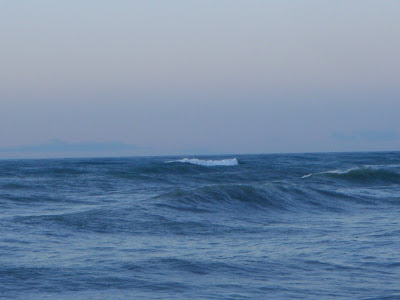Ver mapa más grandeThis island group is so small and insignificant that it barely shows on Google Earth. Columbrete Grande is the only lump of rock in this small volcanic archipelago that makes a suitable stopover. Formed by a crater, at one time the island would have been round, however, yearly onslaught from northeasterly storms have eroded the rim and flooded the crater leaving a convenient horseshoe shape.
 The Greeks and Romans used the anchorage but the Columbretes Islands themselves were snake infested–a feature reflected in the names Colubraria or Ophiusa (meaning snake in Latin) that appear on Roman charts. Up until the 19th century Barbary Corsairs, smugglers and fishermen had the run of the place. In 1856 intentional fires razed the scrub in a deliberate attempt to finish off the snakes and a lighthouse was built. Two families of keepers were permanently installed. The hard, difficult lives of the people who lived on the island over the hundred odd years in which the lighthouse was manned are remembered in a small museum.
The Greeks and Romans used the anchorage but the Columbretes Islands themselves were snake infested–a feature reflected in the names Colubraria or Ophiusa (meaning snake in Latin) that appear on Roman charts. Up until the 19th century Barbary Corsairs, smugglers and fishermen had the run of the place. In 1856 intentional fires razed the scrub in a deliberate attempt to finish off the snakes and a lighthouse was built. Two families of keepers were permanently installed. The hard, difficult lives of the people who lived on the island over the hundred odd years in which the lighthouse was manned are remembered in a small museum.
The lighthouse became automatic in 1975 and the islands were put to use by the Spanish navy as a shooting range, which greatly hastened erosion. In 1988 the islands were declared a natural park and a marine reserve. Now, during the summer months, a few biologists husband the delicate ecosystem, classify the fauna and receive visiting yachts.
There are a limited number of mooring buoys spread around the anchorage and yachts approaching the islands and wanting to make use of a buoy have to call up the biologists on channel 9 and request a mooring. I duly complied and called the islands on the VHF just as the sun was setting. I was still ten miles away and the wind that had sprung up mid afternoon was beginning to fade. Soon it would be time to row again and I knew that the islands could still be up to 5 hours away. However I wanted to get the call in early as I had a special request to make. There’s no mobile phone cover on the island, which is a recommendation, but I needed to reassure my family that I had arrived. So, identifying myself as ‘small sailing boat Onawind Blue’, I radioed the island and asked if they could put in a satellite call to my home and make reassuring noises. A biologist dryly acquiesced but went on to tell me that there were no buoys available and that I would have to tie up to another boat.
The wind failed as darkness fell. And after a long three-hour row the waxing moon, orange as a piece of tangerine, set behind the southern tip of the island. There were no lights and the land was only slightly darker than the dark sky. Were it not for the lighthouse beam swinging round with regularity, its reflection reaching across the oily black water, I would have lost the island into the night.
From experience I know that it’s no fun rafting up against a larger boat, even when there are plenty of helpful crew and fenders. As I rowed into the bay at 1 am and toured the dark sleeping hulls one after the other it seemed that none were suitable. Eventually though I came across a yacht with an oversized RIB bobbing quietly behind. I tied OB’s starboard bow to the RIB’s port quarter and protected her port side with fenders. At 2 am I climbed into my bivi bag, 22 hours after leaving Ibiza. The night was far from quiet, noisy groups of seabirds were still gossiping on the rocks and one particular bird seemed to enquire, in a cockney accent, ‘Awright? Awright?’
‘Yeah, I’m awright.’ I said and fell asleep.
 The trawler fleet return to Vilanova harbour in the watery afternoon light.
The trawler fleet return to Vilanova harbour in the watery afternoon light.
 The more modern boats have the aggressive features of natural predators.
The more modern boats have the aggressive features of natural predators. 
 Not all returning boats trail a cloud of seagulls. Please tell me that this is because they have already sorted and stowed the catch and not that the nets came up empty.
Not all returning boats trail a cloud of seagulls. Please tell me that this is because they have already sorted and stowed the catch and not that the nets came up empty.



















.jpg)




































